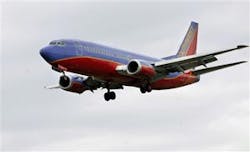Airlines See Increase in 1Q Revenue
DALLAS_Travelers are boarding planes in increasing numbers and are paying more for tickets, boosting revenue at U.S. airlines, but the carriers continue to struggle with jet fuel prices that could be headed even higher.
Southwest Airlines Co., Continental Airlines Inc. and Alaska Air Group Inc. all said Thursday that their first-quarter revenue jumped by double-digit amounts, but only Southwest earned a profit.
Airline executives worry whether consumers facing $3 a gallon gasoline and higher utility bills will have enough left over to take airplane trips, especially with air fares rising.
Earlier this week, American Airlines added $10 to its leisure fares, a move that was quickly matched by most other major carriers. There have been more than a dozen increases since the beginning of last year, driving up prices on some routes more than 50 percent.
"I think you can push fares only so far and there will be a negative effect and a backlash by customers," said Southwest Chief Executive Gary Kelly.
But so far, demand for air travel is holding up very well, said Continental Chairman and CEO Larry Kellner.
"I would have predicted you would have seen more impact by now, so I'm just not sure where the line is," Kellner said. "There is no question that as prices continue to increase, that should have an impact on demand."
Helane Becker, an analyst with The Benchmark Co., predicted that the airlines will have a strong summer travel season despite the higher prices. But, she said, doubts are growing about the second half of the year.
"If oil prices stay high, and people with big SUVs are paying $100 to fill their tank, anybody who hasn't already planned a vacation probably won't go," Becker said.
In its report Thursday, Dallas-based Southwest, a leader among low-cost airlines, said it earned $61 million, or 7 cents per share, in the January-March quarter. That compared to a profit of $59 million, or 7 cents a share, a year earlier, and matched the expectation of analysts, according to a survey by Thomson Financial.
Revenue soared 21 percent to $2.02 billion, boosted by higher fares and more miles flown by paying passengers. The average Southwest flight was 69.2 percent full, up 3.8 points from a year ago.
But the real secret to Southwest's recent success has been paying less for fuel than do its rivals.
Southwest buys more than two-thirds of its fuel at deep discounts because it bought options to buy that fuel when prices were lower. Southwest estimates that it saved $133 million in the quarter - more than its total profit - by this practice of hedging.
Southwest spends about $1.51 per gallon, compared to $1.90 per gallon for Continental.
But this trick will soon lose much of its magic, even for Southwest. The airline has only hedged about one-third of its fuel for 2008 and 2009, which officials admit is less protection than they would like. But high oil prices make it prohibitive to buy more options.
Despite the fuel outlook, Southwest continues to add flights and took the bullish step Thursday of converting options to buy 79 Boeing 737 jets into firm orders. The planes carry a total sticker price of about $4.5 billion, although airlines frequently negotiate discounts.
Houston-based Continental reported a first-quarter loss of $66 million, or 76 cents per share, compared to a loss of $186 million, or $2.79 per share a year ago. Excluding a loss of $20 million from special items, Continental's loss totaled $46 million, or 53 cents per share.
Analysts polled by Thomson Financial expected a loss of 62 cents per share.
Continental's revenue jumped 17.6 percent, to $2.95 billion.
Since jets need fuel to fly, the airlines are looking elsewhere to cut costs. Continental ratified a new contract with flight attendants during the first quarter that, combined with similar agreements with other workers, will save the airline about $500 million a year.
Alaska Air Group, which operates Alaska Airlines and Horizon Air, lost $79.1 million, or $2.36 per share in the first quarter, compared to a loss of $80.5 million, or $2.39 per share, a year earlier.
But the Seattle-based company would have posted a profit of $2.8 million except for a charge to reflect the lower value of its aging fleet of MD-80s, which its airlines are dropping as they switch to an all-Boeing 737 fleet.
On that basis, Alaska easily beat the analysts' forecast of a loss of 56 cents per share. Ray Neidl, an analyst with Calyon Securities, said the operating profit plus a bullish outlook for the summer helped lift Alaska shares.
Revenue rose 14 percent to $735.4 million, helped by passenger traffic increases of 14.8 percent at Horizon and 4.7 percent at Alaska Airlines.
All three airlines reported strong traffic, and so did AMR Corp.'s American Airlines on Wednesday. That's despite 17 major fare increases since January 2005, according to Tom Parsons, who runs Bestfares.com, a discount travel site. He said as long as airlines keep seeing customers lining up for flights, there will be no end to the hikes.
"We're going to see a record number of passengers this July, and the cheap seats just won't be there," he said.
Southwest shares fell 88 cents, or 5.1 percent, to close at $16.48 on the New York Stock Excxhange, while Continental shares dropped $1.18, or 4.5 percent, to $24.81 and shares of Alaska Air Group rose $1.65, or 4.7 percent, to $37.05.
